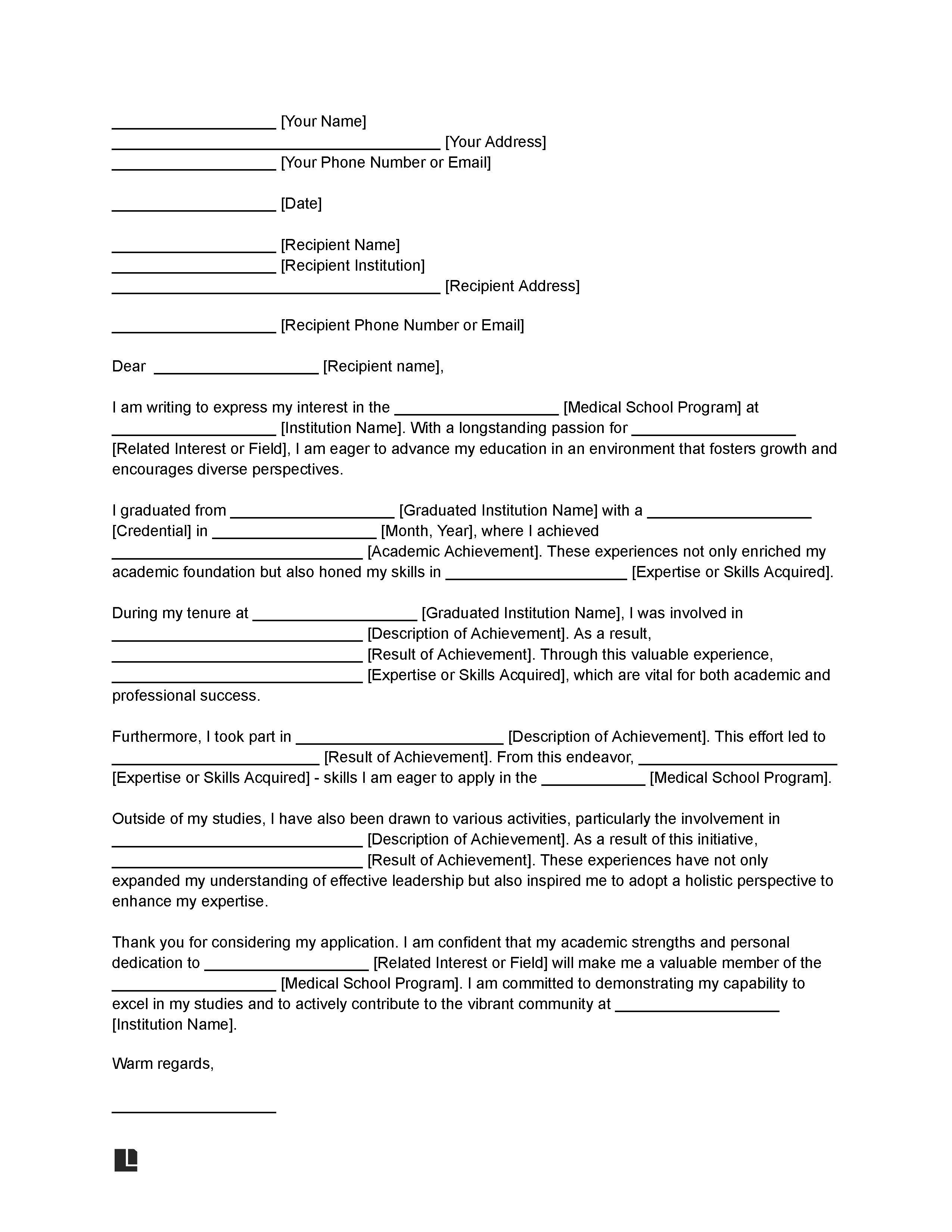A medical school letter of intent is a formal declaration of your sincere interest in attending a particular medical school. This document is crucial in the competitive medical school application process as it allows you to reaffirm your commitment and enthusiasm for the school.
Why Write
- Demonstrates Commitment: Shows the admissions committee your serious intention to join their program.
- Personalizes Your Application: Highlights your specific interest and fit for the school.
- Updates on Achievements: Provides a platform to share new accomplishments or experiences since your initial application.
Medical School Application Timeline
The process is lengthy and typically spans over a year. Here’s a detailed timeline to help you understand each stage:
1. Pre-Application Phase (1-2 Years Before Applying)
- Research: Investigate various medical schools to understand their prerequisites, curriculum, and standards. Attend open houses, talk to current students, and explore each school’s website.
- Coursework and GPA: Ensure you complete the required pre-med courses with a strong GPA. Schools often look for excellence in science courses.
- Extracurricular Activities: Engage in meaningful extracurricular activities, such as volunteering, research, shadowing physicians, and leadership roles. These experiences enrich your application and help you stand out.
2. MCAT Preparation and Taking the Exam (6-12 Months Before Applying)
- MCAT Preparation: Dedicate several months to studying for the Medical College Admission Test (MCAT). Utilize prep courses, study guides, and practice tests.
- Take the MCAT: Aim to take the MCAT at least a year before you plan to start medical school. This allows time to retake the exam if necessary.
3. Application Phase (June-July)
- Primary Application: Submit your primary application through the American Medical College Application Service (AMCAS) or other relevant application services (e.g., AACOMAS for DO schools, TMDSAS for Texas schools). This includes your personal statement, coursework, extracurricular activities, and MCAT scores.
- Transcripts and Letters of Recommendation: Request official transcripts and letters of recommendation from professors and professionals who can vouch for your qualifications and character.
4. Secondary Applications (July-September)
- Secondary Applications: After submitting your primary application, you will receive secondary applications from individual medical schools. These applications include additional essays and questions specific to each school.
- Submit Promptly: Aim to complete and submit secondary applications within two weeks of receiving them to demonstrate your enthusiasm and organizational skills.
5. Interviews (September-March)
- Interview Invitations: If selected, you will receive invitations to interview at medical schools. This is a critical phase where you can showcase your personality, professionalism, and fit for the school.
- Preparation: Practice common interview questions, participate in mock interviews, and research each school thoroughly to tailor your responses.
6. Post-Interview Phase (October-April)
- Thank-You Notes: Send thank-you notes to your interviewers to express your appreciation and reaffirm your interest.
- Letter of Intent (LOI): If you have a top-choice school, send an LOI to reiterate your strong interest and commitment to attending if accepted.
When to Send an LOI
Timing: Typically, you send an LOI after your interview but before final decisions are made or if waitlisted by your top school to improve admission chances.
Step-by-Step Guide to Writing Your Medical School LOI
Step 1 – Introduction
Start with a formal greeting and a clear statement of your intent.
Example: “Dear [Admissions Committee/Dean’s Name],
I am writing to express my sincere interest in attending [Medical School Name]. After careful consideration, I am confident that [Medical School Name] is my top choice for my medical education.”
Step 2 – Expression of Commitment
Explicitly state your intent to attend the school if offered admission.
Example: “If given the opportunity, I am committed to enrolling at [Medical School Name] and becoming an active member of your esteemed institution.”
Step 3 – Reasons for Interest
Explain why you are passionate about this medical school. Mention specific programs, faculty, research opportunities, or aspects of the school’s culture that attract you.
Example: “I am particularly drawn to [Medical School Name] because of its strong emphasis on [specific program or aspect]. The opportunity to work with [specific professor or department] aligns perfectly with my interests in [specific field or research].”
Step 4 – Fit and Contributions
Discuss how your background, experiences, and goals align with the school’s mission and values. Mention how you can contribute to the school community.
Example: “With my background in [your background], I believe I can contribute significantly to [Medical School Name]’s community. My experience in [specific experience] has prepared me to [how you will contribute].”
Step 5 – Recent Updates
Provide any new information that strengthens your application. This could include new research, publications, volunteer work, or other relevant accomplishments.
Example: “Since submitting my application, I have continued to build on my experience in [specific field]. Recently, I [specific accomplishment], which further solidified my passion for [specific aspect of medicine].”
Step 6 – Conclusion
Conclude by reiterating your strong interest and thanking the admissions committee for their time and consideration.
Example: “I remain enthusiastic about the prospect of joining [Medical School Name] and am eager to contribute to its vibrant community. Thank you for considering my application. I look forward to the possibility of contributing to the future of medicine at [Medical School Name].
Sincerely, [Your Name] [Your AMCAS ID]”
Letter of Intent vs. Update Letter for Medical Schools
Letter of Intent: Expresses your commitment to attend a specific medical school if accepted. It highlights your strong interest and reasons why the school is your top choice.
Update Letter: Informs the admissions committee of new accomplishments or changes since submitting your application, such as awards, job promotions, or academic publications.
Key Differences:
- Purpose: A Letter of Intent shows your commitment; an Update Letter provides new information.
- Timing: A Letter of Intent is sent while awaiting a decision from your top choice. An Update Letter is sent whenever you have significant updates to share.
Medical School Letter of Intent Sample
Download a template available in PDF or MS Word formats.



